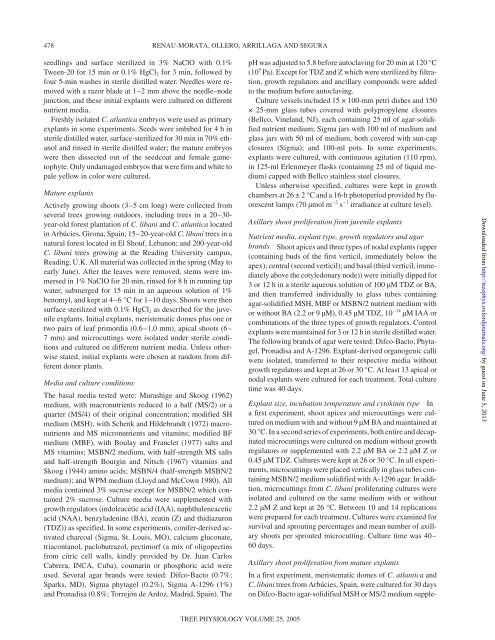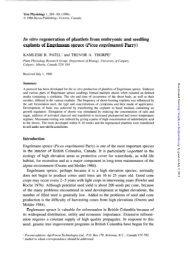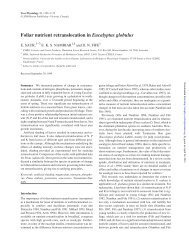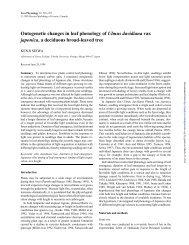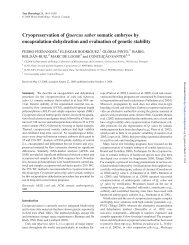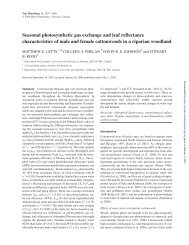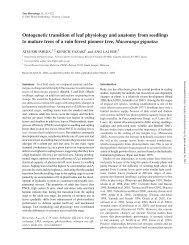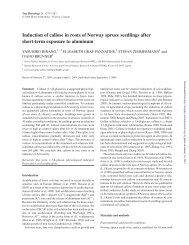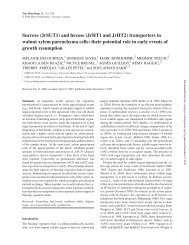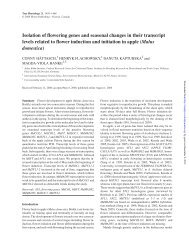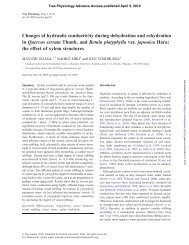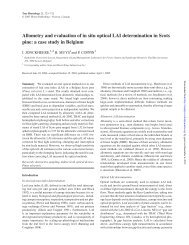Factors influencing axillary shoot proliferation and ... - Tree Physiology
Factors influencing axillary shoot proliferation and ... - Tree Physiology
Factors influencing axillary shoot proliferation and ... - Tree Physiology
Create successful ePaper yourself
Turn your PDF publications into a flip-book with our unique Google optimized e-Paper software.
478 RENAU-MORATA, OLLERO, ARRILLAGA AND SEGURA<br />
seedlings <strong>and</strong> surface sterilized in 3% NaClO with 0.1%<br />
Tween-20 for 15 min or 0.1% HgCl2 for 3 min, followed by<br />
four 5-min washes in sterile distilled water. Needles were removed<br />
with a razor blade at 1–2 mm above the needle–node<br />
junction, <strong>and</strong> these initial explants were cultured on different<br />
nutrient media.<br />
Freshly isolated C. atlantica embryos were used as primary<br />
explants in some experiments. Seeds were imbibed for 4 h in<br />
sterile distilled water, surface-sterilized for 30 min in 70% ethanol<br />
<strong>and</strong> rinsed in sterile distilled water; the mature embryos<br />
were then dissected out of the seedcoat <strong>and</strong> female gametophyte.<br />
Only undamaged embryos that were firm <strong>and</strong> white to<br />
pale yellow in color were cultured.<br />
Mature explants<br />
Actively growing <strong>shoot</strong>s (3–5 cm long) were collected from<br />
several trees growing outdoors, including trees in a 20–30year-old<br />
forest plantation of C. libani <strong>and</strong> C. atlantica located<br />
in Arbúcies, Girona, Spain; 15–20-year-old C. libani trees in a<br />
natural forest located in El Shouf, Lebanon; <strong>and</strong> 200-year-old<br />
C. libani trees growing at the Reading University campus,<br />
Reading, U.K. All material was collected in the spring (May to<br />
early June). After the leaves were removed, stems were immersed<br />
in 1% NaClO for 20 min, rinsed for 8 h in running tap<br />
water, submerged for 15 min in an aqueous solution of 1%<br />
benomyl, <strong>and</strong> kept at 4–6 °C for 1–10 days. Shoots were then<br />
surface sterilized with 0.1% HgCl2 as described for the juvenile<br />
explants. Initial explants, meristematic domes plus one or<br />
two pairs of leaf primordia (0.6–1.0 mm), apical <strong>shoot</strong>s (6–<br />
7 mm) <strong>and</strong> microcuttings were isolated under sterile conditions<br />
<strong>and</strong> cultured on different nutrient media. Unless otherwise<br />
stated, initial explants were chosen at r<strong>and</strong>om from different<br />
donor plants.<br />
Media <strong>and</strong> culture conditions<br />
The basal media tested were: Murashige <strong>and</strong> Skoog (1962)<br />
medium, with macronutrients reduced to a half (MS/2) or a<br />
quarter (MS/4) of their original concentration; modified SH<br />
medium (MSH), with Schenk <strong>and</strong> Hildebr<strong>and</strong>t (1972) macronutrients<br />
<strong>and</strong> MS micronutrients <strong>and</strong> vitamins; modified BF<br />
medium (MBF), with Boulay <strong>and</strong> Franclet (1977) salts <strong>and</strong><br />
MS vitamins; MSBN/2 medium, with half-strength MS salts<br />
<strong>and</strong> half-strength Bourgin <strong>and</strong> Nitsch (1967) vitamins <strong>and</strong><br />
Skoog (1944) amino acids; MSBN/4 (half-strength MSBN/2<br />
medium); <strong>and</strong> WPM medium (Lloyd <strong>and</strong> McCown 1980). All<br />
media contained 3% sucrose except for MSBN/2 which contained<br />
2% sucrose. Culture media were supplemented with<br />
growth regulators (indoleacetic acid (IAA), naphthaleneacetic<br />
acid (NAA), benzyladenine (BA), zeatin (Z) <strong>and</strong> thidiazuron<br />
(TDZ)) as specified. In some experiments, conifer-derived activated<br />
charcoal (Sigma, St. Louis, MO), calcium gluconate,<br />
triacontanol, paclobutrazol, pectimorf (a mix of oligopectins<br />
from citric cell walls, kindly provided by Dr. Juan Carlos<br />
Cabrera, INCA, Cuba), coumarin or phosphoric acid were<br />
used. Several agar br<strong>and</strong>s were tested: Difco-Bacto (0.7%;<br />
Sparks, MD), Sigma phytagel (0.2%), Sigma A-1296 (1%)<br />
<strong>and</strong> Pronadisa (0.8%; Torrejón de Ardoz, Madrid, Spain). The<br />
TREE PHYSIOLOGY VOLUME 25, 2005<br />
pH was adjusted to 5.8 before autoclaving for 20 min at 120 °C<br />
(10 5 Pa). Except for TDZ <strong>and</strong> Z which were sterilized by filtration,<br />
growth regulators <strong>and</strong> ancillary compounds were added<br />
to the medium before autoclaving.<br />
Culture vessels included 15 × 100-mm petri dishes <strong>and</strong> 150<br />
× 25-mm glass tubes covered with polypropylene closures<br />
(Bellco, Vinel<strong>and</strong>, NJ), each containing 25 ml of agar-solidified<br />
nutrient medium; Sigma jars with 100 ml of medium <strong>and</strong><br />
glass jars with 50 ml of medium, both covered with sun-cap<br />
closures (Sigma); <strong>and</strong> 100-ml pots. In some experiments,<br />
explants were cultured, with continuous agitation (110 rpm),<br />
in 125-ml Erlenmeyer flasks (containing 25 ml of liquid medium)<br />
capped with Bellco stainless steel closures.<br />
Unless otherwise specified, cultures were kept in growth<br />
chambers at 26 ± 2 °C <strong>and</strong> a 16-h photoperiod provided by fluorescent<br />
lamps (70 µmol m –2 s –1 irradiance at culture level).<br />
Axillary <strong>shoot</strong> <strong>proliferation</strong> from juvenile explants<br />
Nutrient media, explant type, growth regulators <strong>and</strong> agar<br />
br<strong>and</strong>s Shoot apices <strong>and</strong> three types of nodal explants (upper<br />
(containing buds of the first verticil, immediately below the<br />
apex); central (second verticil); <strong>and</strong> basal (third verticil, immediately<br />
above the cotyledonary node)) were initially dipped for<br />
3 or 12 h in a sterile aqueous solution of 100 µM TDZ or BA,<br />
<strong>and</strong> then transferred individually to glass tubes containing<br />
agar-solidified MSH, MBF or MSBN/2 nutrient medium with<br />
or without BA (2.2 or 9 µM), 0.45 µM TDZ, 10 –14 µM IAA or<br />
combinations of the three types of growth regulators. Control<br />
explants were maintained for 3 or 12 h in sterile distilled water.<br />
The following br<strong>and</strong>s of agar were tested: Difco-Bacto, Phytagel,<br />
Pronadisa <strong>and</strong> A-1296. Explant-derived organogenic calli<br />
were isolated, transferred to their respective media without<br />
growth regulators <strong>and</strong> kept at 26 or 30 °C. At least 13 apical or<br />
nodal explants were cultured for each treatment. Total culture<br />
time was 40 days.<br />
Explant size, incubation temperature <strong>and</strong> cytokinin type In<br />
a first experiment, <strong>shoot</strong> apices <strong>and</strong> microcuttings were cultured<br />
on medium with <strong>and</strong> without 9 µM BA <strong>and</strong> maintained at<br />
30 °C. In a second series of experiments, both entire <strong>and</strong> decapitated<br />
microcuttings were cultured on medium without growth<br />
regulators or supplemented with 2.2 µM BA or 2.2 µM Z or<br />
0.45 µM TDZ. Cultures were kept at 26 or 30 °C. In all experiments,<br />
microcuttings were placed vertically in glass tubes containing<br />
MSBN/2 medium solidified with A-1296 agar. In addition,<br />
microcuttings from C. libani proliferating cultures were<br />
isolated <strong>and</strong> cultured on the same medium with or without<br />
2.2 µM Z <strong>and</strong> kept at 26 °C. Between 10 <strong>and</strong> 14 replications<br />
were prepared for each treatment. Cultures were examined for<br />
survival <strong>and</strong> sprouting percentages <strong>and</strong> mean number of <strong>axillary</strong><br />
<strong>shoot</strong>s per sprouted microcutting. Culture time was 40–<br />
60 days.<br />
Axillary <strong>shoot</strong> <strong>proliferation</strong> from mature explants<br />
In a first experiment, meristematic domes of C. atlantica <strong>and</strong><br />
C. libani trees from Arbúcies, Spain, were cultured for 30 days<br />
on Difco-Bacto agar-solidified MSH or MS/2 medium supple-<br />
Downloaded from<br />
http://treephys.oxfordjournals.org/ by guest on June 5, 2013


